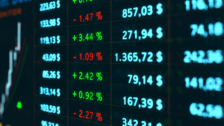Capping upside the trade-off for predictable share investing
Defined-return investing is not normally something that is associated with the share market, but strategies that seek to deliver a pre-determined rate of return over a specified period of time do exist.
For a variety of reasons, the defined-return approach has not worked well in Australia, a legacy of the blow-up of many ‘structured products’ sold to retail investors prior to the GFC crash in 2007-08, which in many cases gave return outcomes vastly different to what was considered ‘defined’.
London-based manager Atlantic House Investments wants to dispel any lingering ill-feeling over the defined-return genre in Australia, by offering its Atlantic House Defined Returns Fund, to be distributed by Mantis Funds. The exposure will be through an Australian unit trust feeding into a newly created Australian-dollar-hedged share class of the manager’s flagship $3 billion Atlantic House Defined Returns Fund, domiciled in Dublin.
The new fund aims to deliver predictable long-term returns of 7 per cent to 8 per cent a year, in “all but the bleakest market conditions,” says the marketing literature. The Inside Adviser asked Andrew Lakeman (pictured), founder of Atlantic House Group, to unpack what that means.
“The fund aims to give investors exposure to the long-term returns of equities with a degree of downside protection over the long term,” Lakeman says.
“It gives you the potential of an annualised return of 7 per cent to 8 per cent in rising, flat, and even most falling equity market environments, over the medium to long term. You should be able to predict, relatively accurately, your short-, medium- and long-term returns in different market conditions. A lot of investors have cash flow requirements they need to meet, and typically, that has been met through cash and fixed-income investments. We see this fund as playing a role there.”
Investors will have a higher probability of achieving that annualised return of 7 per cent to 8 per cent than if they invest directly in the equity markets Atlantic House uses, says Lakeman; but their equity upside is capped at 8 per cent.
The manager buys equity exposure to large developed-market equity indices, for example, the S&P 500, the UK FTSE 100 Index, the Euro STOXX 50 index and Japan’s Nikkei 225. Atlantic House uses ‘autocalls’ over these indices: autocalls are typically linked to a single underlying index, and offer the potential of a fixed capital return if the indices to which they are linked are at or above their starting level, on given dates (they can also be configured to pay an income). Atlantic House does not buy the autocalls; it uses derivatives to structure the return profile of the autocalls.
That gives it the equity exposure: the collateral backing the fund is typically gilts (UK government bonds) that Atlantic House buys and holds, swapping-out the interest rate risk. Using gilts helps to mitigate credit and counter-party risk.
“We use a rules-based approach to take positions in these derivative instruments, which we call ‘defined return investments’, that are linked to the performance of one or more large equity index,” Lakeman says.
“Each defined return investment will deliver its target return as long as the indices to which it is linked do not fall by more than about 25 per cent – and remain at or below that level – over the life of the investment, which is typically about six years. Each individual investment will not suffer a loss even if the indices to which it is linked were to fall by up to 35 per cent from their starting levels, and remain there until maturity.”
Because the fund gets its equity exposure through derivatives, Lakeman says the portfolio managers can use their derivative pricing models to predict how the fund is likely to perform over various timeframes, and various market (that is, index) movement scenarios.
“The portfolio managers can precisely target specific levels of risk and return, harnessing the equity risk premium,” he says. “We think this relative predictability gives investors transparency around likely performance, and helps them make more informed investment decisions.”
Ah, but what about the disclaimer, “in all but the bleakest market conditions”?
“If markets fall significantly – by approximately one-third – and remain depressed for a prolonged period, the fund will fall approximately in line with the worst-performing underlying index, minus any dividends,” Lakeman says. “Over shorter timeframes, the fund may experience levels of volatility higher than the share markets on which its investments are based.”
In summary, the fund will not like a market fall of 35 per cent or more: in that case, it will go down with the market. It would not like a market rise of 35 per cent, either; it won’t share in that, but will meet its 7 per cent to 8 per cent annualised return target.
And in a feature that will be welcomed by those investors with experience of the pre-GFC heyday of structured products, the Australian unit trust will offer daily liquidity. The minimum investment is $25,000.











